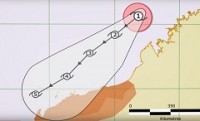Tropical Cyclone season to be more active for NW Australia
10/10/2016

Northwest Australia can expect the tropical cyclone season to be more active than last season according to the Bureau of Meteorology Tropical Cyclone Seasonal Outlook released today.
Acting Regional Director for Western Australia, Mr Grahame Reader, said it is important that residents are not complacent ahead of the start of the season on 1 November.
“Over the past 5 years the number of significant cyclone and flood impacts has been well below average, and the 2015-16 season was a very quiet one, with only Tropical Cyclone Stan impacting the WA coast at the end of January 2016.” he said.
According to the outlook released today, Mr Reader said that climate models are indicating an average to above average number of tropical cyclones this season, but he cautioned that the number of tropical cyclones is not a good indicator of the threat to communities.
"If just one cyclone impacts a community with destructive winds or flooding, then that will be a bad season for that community". The tropical cyclone seasons runs from 1 November to 30 April.
Department of Fire and Emergency Services (DFES) Country Assistant Commissioner Graham Swift is urging people in the northwest to be ready, even if they think they’re not at risk.
“Just because you haven’t been impacted by a devastating cyclone previously, doesn’t mean it couldn’t happen to you this year - all it takes is one cyclone to change your life” Assistant Commissioner Swift said.
Communities in the State’s north remain at serious risk of the devastation of cyclones and need to prepare now to keep their homes and loved ones safe.
Keeping safe is as simple as securing outdoor items like boats or trailers, preparing an emergency kit and taking heed of the community warnings.
Summary of the Tropical Cyclone Seasonal Outlook for Western Australia:
- A 63% chance of an above average number of tropical cyclones in waters off the northwest coast (average number is five).
- Likelihood of around two coastal impacts.
- Significant risk of at least one severe tropical cyclone coastal impact during the season.
More information:
- Tropical cyclone warnings and information: www.bom.gov.au/cyclone
- National Tropical Cyclone Outlook: http://www.bom.gov.au/climate/cyclones/australia/
- WA rainfall and river conditions: www.bom.gov.au/wa/flood/
- Visit the DFES website for more information on preparing for cyclones and floods: www.dfes.wa.gov.au/safetyinformation/cyclone/Pages/publications.aspx










